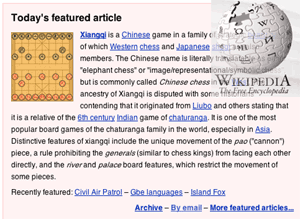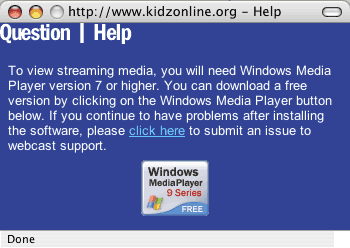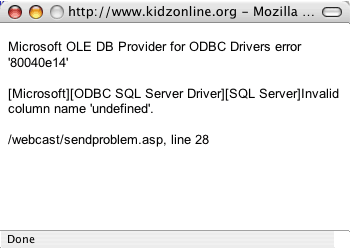Steve Dembo posted his latest podcast yesterday. With most educators on break now and taking some time off from edutech stuff, I am on the edge of my seat looking and waiting for new education programs. Steve’s latest is well worth the wait. In his easy style, yet thought-provoking way of speaking (from way outside the box), Dembo has posed some suggestions and asked some important questions.
 Essentially, his supposition is that when we attend conferences, we find ourself in rooms with a speaker who has arranged content to be delivered using presentation, and in the case of our conferences (tech & education), multimedia of one ilk or another. Admittedly, its the same kind of thing we’re trying to get away from in the classroom.
Essentially, his supposition is that when we attend conferences, we find ourself in rooms with a speaker who has arranged content to be delivered using presentation, and in the case of our conferences (tech & education), multimedia of one ilk or another. Admittedly, its the same kind of thing we’re trying to get away from in the classroom.
At the same time, we are sharing the room with other educators, who in many cases know as much, if not more, about the presented topics, and certainly could add value from their varied experiences.
You can listen to the podcast at:
Necc all wrapped up.
OK, here’s my 2¢ worth, and this comes from my perspective as someone who spends a great deal of time presenting at conferences, and, a fact much relevance here, makes much of his living presenting at conferences.
I believe that of all the factors related to this problem, including technology, infrastructure, content, presentation skills, etc., time is the one that is most critical to success. This is certainly no different in our classrooms. I typically have an hour for my presentations, though it can range from 45 to 90 minutes.
Sometimes I do scripted presentations that are carefully planned and assembled, almost choreographed. You might even call them performances, with cognitive and behavioral objectives. Other times, the presentation is more open, with a lot of discussion and sharing of ideas. I present a surprising statistic or an off-edge opinion, and ask people to share their reactions within the context of their job practices and goals. We build ideas in collaboration and it is extremely useful and a lot of fun, and I’m told that I’m pretty good at this sort of facilitation.
However, at the end of the session, if you ask me which hour is more satisfying in terms of what I have accomplished with the audience, its the performance, hands down. Give me a day, I’m going to get more done by facilitating learning by sharing, what I believe Steve is talking about.
However, given an hour or two, I’m going to be able to accomplish much more by presenting ideas and techniques to the audience in a well prepared, rehearsed, multimedia performance. Now it is possible and advisable to integrate into the performance, elements of interactivity, but only where they will result in conclusions that integrate into the performance.
I agree with Steve, 100%, that there is talent, skill, and perspective in the presentation room that is being wasted in the standard dog and pony show. However, technologies are emerging that can help us to tap into those opportunities. The question that I ask is what is the best use of that hour, and what is the best use of the digital information infrastructure that extends past that hour and that presentation room. In which arena should the audience be listening and watching, and in which should they be collaborating.
I suspect that there is no hard rule here. I think that Steve is correct when it comes to the podcasting. I’d planned to record my podcasting presentation at NECC, but with the tech difficulties we had, I didn’t get around to wiring myself up for it. I have to say that I would not want a keynote podcasted. My client is paying for the performance, and I want to continue to be paid for it. I’d decided, that if anyone asked if they could record my spotlight session at NECC, I’d agree if they released any 5 minutes of it as part of a podcast. But no more than 5 minutes. Alas, no one asked.
I agree with Steve that there is a vast un-tapped resource in the presentation room. It think that we need to start refining just how we can drill it out and spread it.
I am trying to take advantage of these emerging technologies with my presentations. For NECC, all of my online handouts were wiki pages, and I invited the audience to adapt and add to the handouts. For the podcasting session, I got additions from Steve, and from veteran podcasters Jeff Moore, Bud Hunt, and Eric Jefcoat. I also included a page with a built-in RSS aggregator that captures and lists any Technorati-aware blog that mentions certain keywords associated with the presentation. Harnessing the post presentation conversation. There are currently 14 posts listed, including some from before the session.
I don’t know which way is best. It’s probably a combination of the two. One thing that I do know is that the presentation point, its time and place, must be a springboard to bigger things. And understanding that, I suspect that WiFi in the presentation room, has become as essential as the LCD projector. It’s about sharing, and extending the sharing.
2¢ worth.
PS: Mike Lawerence, Executive Director of California’s CUE, says that conferences are people aggregators. I would tend to agree, especially when considering Steve’s ideas about sharing the wealth of talent.
Tokyo, July 13, 2005  Fujitsu Laboratories Ltd., Fujitsu Frontech Limited, and Fujitsu Limited today announced their joint development of the world’s first film substrate-based bendable color electronic paper with an image memory function. The new electronic paper features vivid color images that are unaffected even when the screen is bent, and features an image memory function that enables continuous display of the same image without the need for electricity. The thin and flexible electronic paper uses very low power to change screen images, thereby making it ideal for displaying information or advertisements in public areas as a type of new electronic media that can be handled as easily as paper.

 two interviews with NECC attendees, who also happened to be ISTE affiliate officials as well. They both mentioned blogs and podcasting as the technologies the were interested in learning more about, and they talked about these technologies within a context that I want to hone down to a finer point. Actually, it is my nature to hone things down to three points — four if there’s no way around it.
two interviews with NECC attendees, who also happened to be ISTE affiliate officials as well. They both mentioned blogs and podcasting as the technologies the were interested in learning more about, and they talked about these technologies within a context that I want to hone down to a finer point. Actually, it is my nature to hone things down to three points — four if there’s no way around it. Windows MediaPlayer (see right). I’d put it off at that point, with no time to explore. Today, I decided to explore. Go deeper. Solve this problem.
Windows MediaPlayer (see right). I’d put it off at that point, with no time to explore. Today, I decided to explore. Go deeper. Solve this problem.
 Essentially, his supposition is that when we attend conferences, we find ourself in rooms with a speaker who has arranged content to be delivered using presentation, and in the case of our conferences (tech & education), multimedia of one ilk or another. Admittedly, its the same kind of thing we’re trying to get away from in the classroom.
Essentially, his supposition is that when we attend conferences, we find ourself in rooms with a speaker who has arranged content to be delivered using presentation, and in the case of our conferences (tech & education), multimedia of one ilk or another. Admittedly, its the same kind of thing we’re trying to get away from in the classroom. Apple Distinguished Educator, Barnaby Wasson, interviewed CoSN Chair, Sheryl Abshire, while at NECC last week. Some time during the night, the podcast recording was posted as part of the
Apple Distinguished Educator, Barnaby Wasson, interviewed CoSN Chair, Sheryl Abshire, while at NECC last week. Some time during the night, the podcast recording was posted as part of the 
 On Tuesday night, I had the pleasure of attending a book reading and signing at one of Raleigh’s independent book stores,
On Tuesday night, I had the pleasure of attending a book reading and signing at one of Raleigh’s independent book stores,